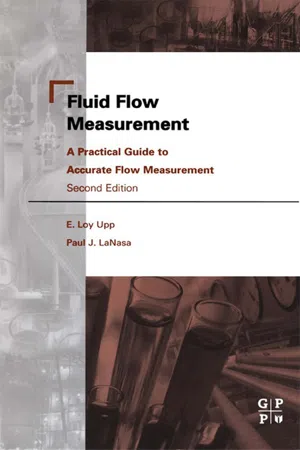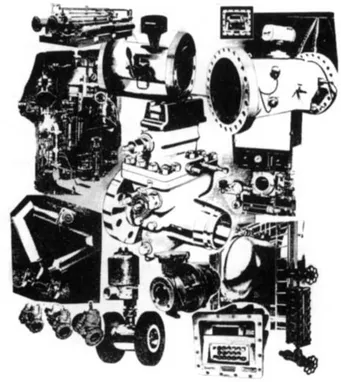
eBook - ePub
Fluid Flow Measurement
A Practical Guide to Accurate Flow Measurement
- 296 pages
- English
- ePUB (mobile friendly)
- Available on iOS & Android
eBook - ePub
About this book
There is a tendency to make flow measurement a highly theoretical and technical subject but what most influences quality measurement is the practical application of meters, metering principles, and metering equipment and the use of quality equipment that can continue to function through the years with proper maintenance have the most influence in obtaining quality measurement. This guide provides a review of basic laws and principles, an overview of physical characteristics and behavior of gases and liquids, and a look at the dynamics of flow. The authors examine applications of specific meters, readout and related devices, and proving systems. Practical guidelines for the meter in use, condition of the fluid, details of the entire metering system, installation and operation, and the timing and quality of maintenance are also included.
This book is dedicated to condensing and sharing the authors' extensive experience in solving flow measurement problems with design engineers, operating personnel (from top supervisors to the newest testers), academically-based engineers, engineers of the manufacturers of flow meter equipment, worldwide practitioners, theorists, and people just getting into the business.
- The authors' many years of experience are brought to bear in a thorough review of fluid flow measurement methods and applications
- Avoids theory and focuses on presentation of practical data for the novice and veteran engineer
- Useful for a wide range of engineers and technicians (as well as students) in a wide range of industries and applications
Frequently asked questions
Yes, you can cancel anytime from the Subscription tab in your account settings on the Perlego website. Your subscription will stay active until the end of your current billing period. Learn how to cancel your subscription.
No, books cannot be downloaded as external files, such as PDFs, for use outside of Perlego. However, you can download books within the Perlego app for offline reading on mobile or tablet. Learn more here.
Perlego offers two plans: Essential and Complete
- Essential is ideal for learners and professionals who enjoy exploring a wide range of subjects. Access the Essential Library with 800,000+ trusted titles and best-sellers across business, personal growth, and the humanities. Includes unlimited reading time and Standard Read Aloud voice.
- Complete: Perfect for advanced learners and researchers needing full, unrestricted access. Unlock 1.4M+ books across hundreds of subjects, including academic and specialized titles. The Complete Plan also includes advanced features like Premium Read Aloud and Research Assistant.
We are an online textbook subscription service, where you can get access to an entire online library for less than the price of a single book per month. With over 1 million books across 1000+ topics, we’ve got you covered! Learn more here.
Look out for the read-aloud symbol on your next book to see if you can listen to it. The read-aloud tool reads text aloud for you, highlighting the text as it is being read. You can pause it, speed it up and slow it down. Learn more here.
Yes! You can use the Perlego app on both iOS or Android devices to read anytime, anywhere — even offline. Perfect for commutes or when you’re on the go.
Please note we cannot support devices running on iOS 13 and Android 7 or earlier. Learn more about using the app.
Please note we cannot support devices running on iOS 13 and Android 7 or earlier. Learn more about using the app.
Yes, you can access Fluid Flow Measurement by E. Loy Upp,Paul J. LaNasa in PDF and/or ePUB format, as well as other popular books in Mathematics & Mathematics General. We have over one million books available in our catalogue for you to explore.
Information
CHAPTER 1
Introduction
CHAPTER OVERVIEW
The vast majority of this book relates to “conventional” flowmeters, for example, the admonition about single-phase flow. Obviously, this comment does not apply to multiphase meters. Other exceptions are noted as they appear.
The book’s general approach is to look first at basic principles, particularly with respect to differential and linear meters and the types used in the oil and gas industry for fluid flow measurement. After a review of basic reference standards, “theory” is turned into “practice,” followed by an overview of fluids and the fluid characteristics. “Flow” itself is examined next, followed by operating and maintenance concerns. Next, comments are offered on individual meters and associated equipment with a detailed review of the two classes of meters: differential and linear readout systems. Meter proving systems are covered in detail followed by “loss and unaccounted for” procedures. The book concludes with a discussion of conversion to volumes, conversion of the volumes to billing numbers, and the audit procedures required to allow both parties to agree to the final measurement and money exchange.
Emphasis is not so much on individual meter details as on general measurement requirements and the types of meters available to solve particular problems.
Specifically, this first chapter presents some background information, overviews the requisites for “flow” and defines major terms used throughout the book. Chapter 2 introduces various relevant subjects, starting with basic principles and fundamental equations. Chapter 3 details the types of fluid measurement: custody transfer and non-custody transfer. Chapter 4 is devoted entirely to listing basic reference standards. Chapter 5 applies theory to the real world and describes how various practical considerations make effective meter accuracy dependent on much more than simply the original manufacturer’s specifications and meter calibration. Chapter 6 covers the limitations of obtaining accurate flow measurement because of fluid characteristics. Chapter 7 looks at flow in terms of characteristics required, measurement units involved, and installation requirements for proper meter operation.
Chapter 8 reviews the necessary concerns of operating the meters properly with examples of real problems found in the field. Chapter 9 covers the maintenance required on real metering systems to allow proper performance over time. Chapter 10 reviews meter characteristics, with comments on all major meters used in the industry. Chapters 11 and 12 detail head and linear meters. Chapter 13 deals with related readout equipment. Chapter 14 discusses proving systems. Chapter 15 covers material balance calculations and studies (i.e., loss and unaccounted for). Chapter 16 introduces auditing required in oil and gas measurement.
REQUISITES OF FLOW MEASUREMENT
In this book, fluids are common fluids (liquids, gases, slurries, steam, etc.) handled in the oil and gas industry in a generic sense. But each fluid of interest must be individually examined to determine if: (a) it is flashing or condensing; (b) has well defined pressure, volume, temperature (PVT) relationships or density; (c) has a predictable flow pattern based on Reynolds number; (d) is Newtonian; (e) contains no foreign material that will adversely affect the flow meter performance; (e.g., solids in liquids, liquids in gas); (f) has a measurable analysis that changes slowly with time.
The flow should be examined to see if it: (a) has a fairly constant rate or one that does not exceed the variation in flow allowed by the meter system response time; (b) has a non-swirling pattern entering the meter; (c) is not two-phase or multiphase at the meter; (d) is non-pulsating; (e) is in a circular pipe running full; (f) has provision for removing any trapped air (in liquid) or liquid (in gas) prior to the meter. Certain meters may have special characteristics that can handle some of these problems, but they must be carefully evaluated to be sure of their usefulness for the fluid conditions.
Measurement can usually be accomplished with any one of several meter systems, but for a given job, certain meters have earned acceptance for specific applications based on their service record. This is an important factor in choosing a meter. Reference to industry standards and users within an industry are important points to review in choosing the best meter for the given applications.

Figure 1-1 Many different types of meters are available for measuring flow. Proper selection involves a full understanding of all pertinent characteristics relative to a specific measurement job.
BACKGROUND OF FLOW MEASUREMENT
The subjects below form the background for fluid flow measurement that should be understood before embarking on the task of choosing a flow measurement system. “Fluid,” “flow” and “measurement” are defined in generally accepted terms (Webster’s New Collegiate Dictionary) as:
Fluid: 1. having particles that easily move and change their relative position without separation of the mass and that easily yield to pressure; 2. a substance (as a liquid or a gas) tending to flow or conform to the outline of its container.
Flow: 1. to issue or move in a stream; 2. to move with a continual change of place among the consistent particles; 3. to proceed smoothly and readily; 4. to have a smooth, uninterrupted continuity.
Measurement: 1. the act or process of measuring; 2. a figure, extent, or amount obtained by measuring.
Combining these into one definition for fluid flow measurement yields:
Fluid flow measurement: the measurement of smoothly moving particles that fill and conform to the piping in an uninterrupted stream to determine the amount flowing.
Further limitations require that the fluids have a relatively steady state mass flow, are clean, homogenous, Newtonian, and stable with a single-phase non-swirling profile with some limit of Reynolds number (depending ...
Table of contents
- Cover image
- Title page
- Table of Contents
- Copyright
- Dedication
- Preface
- Chapter 1: Introduction
- Chapter 2: Basic Flow Measurement Laws
- Chapter 3: Types of Fluid Flow Measurement
- Chapter 4: Basic Reference Standards
- Chapter 5: From Theory to Practice
- Chapter 6: Fluids
- Chapter 7: Flow
- Chapter 8: Operations
- Chapter 9: Maintenance of Meter Equipment
- Chapter 10: Measurement and Meters
- Chapter 11: Differential (Head) Meters
- Chapter 12: Linear and Special Meters
- Chapter 13: Readouts and Related Devices
- Chapter 14: Proving Systems
- Chapter 15: “Loss and Unaccounted for” Fluids
- Chapter 16: Auditing
- Index